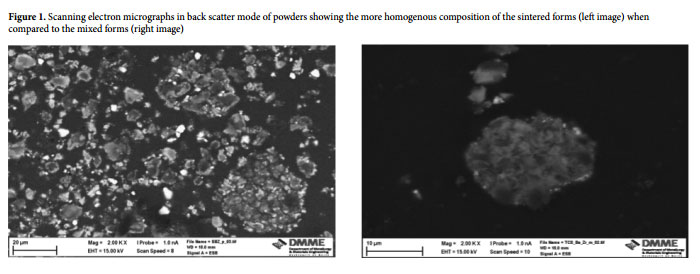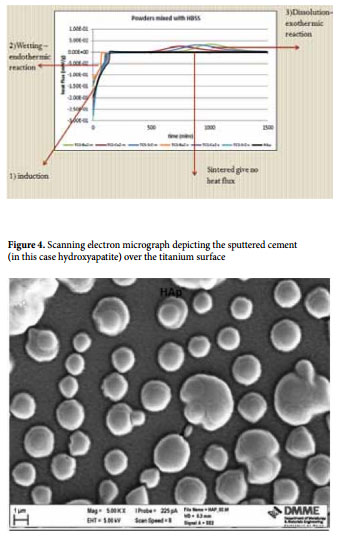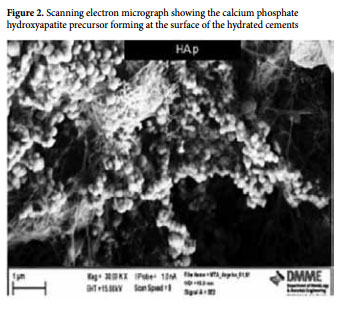Novel dental implant coating materials
Maria Xuereb & Josette Camilleri
Abstract
An implant coating must be biocompatible, not compromise the long term function and success of the prosthesis and must be strong enough to withstand and transfer all loads without delamination. In this study, six different tricalcium silicate cements were investigated in the mixed and sintered form while hydroxyapatite was used as a control. The properties of each material were studied carefully to propose an innovative coating material and coating process. The hypothesis is that there is no difference between the prototype mixed and sintered cements. It is also hypothesised that there will be no difference between the prototype cements and the control hydroxyapatite.
Introduction
A dental implant is a fixture inserted in the jaw bone so as to support a dental prosthesis including a crown, bridge or denture. The purpose is to replace a missing tooth or a number of teeth. The implant actually consists of an abutment holding the fixed prosthesis. Several materials have been proposed as abutment materials including metals such as titanium and its oxides, ceramics, polymers and carbon compounds.
Tricalcium silicate cements have been described as secondary generation cements. They are derived from the first generation tricalcium silicates. The latter are the core materials from which the second generation cements are derived following certain chemical and elemental changes. Tricalcium silicates are actually based on Portland cement, a cement used in construction and buildings, which was introduced to dentistry in the mineral trioxide aggregate material. Unfortunately, Portland cement has impurities like arsenic, lead and chromium which can be leached out and can cause toxicity in the body. It also contains an aluminium phase which has been linked to Alzheimer’s and Parkinson’s disease.1 On the other hand, pure tricalcium silicate cement does not contain any of these impurities as it is not produced in a kiln like Portland cement, but is produced by a solgel method.1
Over the years, dental implant systems have become the most sought after way to replace a missing tooth or teeth. A dental implant can be simplistically described as the replacement for the root of a missing tooth. The latter then serves as an attachment to replace the missing tooth. When an implant is inserted into the bone, a series of bone modelling and remodelling processes, known as osseointegration, are required for the prosthesis to be accepted by the human body and allow healing and integration of the prosthesis. Osseointegration has actually been described as the direct structural and functional connection between the human bone and the prosthesis.2 The most commonly used dental implants are composed of titanium or titanium alloys due to their high biocompatibility, minimal toxicity, high strength and high resistance to corrosion especially since they have to be in contact with tissue fluids in the body on insertion.3,4 The success of such implants has been quoted to be over 95%.3 Still, over the years, different implant coating materials have been proposed so as to improve the osseointegrative potential of implants while giving a biocompatible and non-toxic prosthesis. Even though hydroxyapatite is the most widely used implant coating material, in the literature several cases of delamination and failure of such a coating where the implant coating detaches from the actual implant have been reported.3
The aim of this research was to investigate innovative materials that can be used as implant coatings so as to provide a good biocompatible prosthesis while providing a more costeffective prosthesis when compared to the conventional implants found on the market. One type of coating method, known as magnetron sputtering, was also investigated and used so as to coat titanium stubs to mimic the actual coating process.
A group of secondary generation cements, known as tricalcium silicate cements, were used in this study. These materials were chosen for this study as they have the unique ability of producing calcium hydroxide which then forms hydroxyapatite on being hydrated or upon contact with tissue fluids in the body/physiologic solution in the lab. This characteristic means that they have bioactivity. Several studies have been carried out on these cements in different fields in dentistry.5-7
The main advantage of using the pure tricalcium silicate cement in this study instead of the Portland cement, is to have a pure cement, free from any contaminants and thus being nontoxic.
Methodology
All tricalcium silicates have the disadvantage of not being radiopaque and therefore they cannot be distinguished on X-rays. This is quite a disadvantage since one must monitor the prosthesis radiographically to see if there are any signs of failure or peri-implantitis. For this reason, materials known as radiopacifiers are added so that the prosthesis can be viewed and monitored on X-rays. Due to this, a 20% amount of radiopacifiers, including mixed and sintered barium zirconate, mixed and sintered calcium zirconate and mixed and sintered strontium zirconate were added to 80% of the pure cement.
In this study, hydroxyapatite was used as a control. The mixed variants include the tricalcium silicate cements which were just being mixed with the radiopacifier while the sintered variants include the tricalcium silicate cements and the radiopacifier being heated at high temperatures together so as to form one complex.
Testing of the main characteristics and properties of these cements was carried out with several tests. Elemental analysis was carried out by energy dispersive spectroscopy, x-ray diffraction and infra-red spectroscopy. Surface analysis was carried out by scanning electron microscopy, glancing angle x-ray diffraction, calorimetry, pH assessment, assessment of radiopacity, compressive strength and leachate analysis. The properties of each of the materials on hydration and on contact with physiologic solution were tested for 28 days in an incubator at 37°C.
After the cement characterization, titanium stubs were coated with these cements by magnetron sputtering and the coating obtained was investigated by microscopy and x-ray diffraction analysis so as to mimic the implant coating scenario. This coating method involves high power impulses to deposit materials over a surface.
Results
All the six cements and the control portrayed different properties and characteristics for each test performed. The aim of using a sintered cement, and not just a mixed cement was to obtain a more homogenous material as each cement particle is theoretically bonded to a radiopacifier molecule, whereas with a mixture one can get clumps of radiopacifier in certain areas, with other areas lacking radiopacity as can be seen in figure 1, depending on the mixing process.
This principle was mainly observed with the scanning electron microscopy. On contact with physiologic solution, all the cements portrayed the typical formation of hydroxyapatite at the surface of the material (figure 2). The tricalcium silicate phase was common for all the six tricalcium silicate cements and the control and therefore the reactivity and properties are mainly due to the radiopacifier phases in the cements. From the results obtained from the different tests one may conclude that the radiopacifiers are inert as they do not cause any chemical change in the cement phase present in the sample. Testing the powdered unreacted cements apart from the set cements, after being mixed with water or physiologic solution, allows good characterization of the materials while also allowing the investigators to see what happens upon contact with water and also identify any products formed during the setting reaction. X-ray diffraction can give compound composition identification and thus it can identify crystalline phases contained in the sample to be tested. From all the tests carried out it could be noticed that the sintered cements gave inferior properties when compared to their mixed counterparts especially when considering the strength and reactivity of the materials. On being hydrated, there was a very limited reactivity for the sintered cements while the mixed cements exhibited a mild exothermic reaction thus showing material dissolution (figure 3). Still, even though the sintered cements gave inferior properties to the mixed counterparts, all the sintered cements exhibited better characteristics over the hydroxyapatite which is being commonly used as an implant coating material. This shows that hydroxyapatite is not such an ideal implant coating material. Unfortunately the sintered barium and strontium variants showed high leaching values of the strontium and barium when compared to the calcium variant. This is not an ideal scenario as the metals barium and strontium are leached out in solution and can lead to high toxic amounts. Only zirconium was stable during the leaching analysis when compared to the other radiopacifier components.

Closed-field unbalanced magnetron sputtering was used to co-deposit titanium with an interlayer of zirconia on the titanium stub (figure 4). Even though the coating deposited did not give high peaks of deposited material on the spectra, still, some of the cement was deposited on the surface of the titanium stub thus showing that this type of coating method can actually give some positive results. By applying different sputtering conditions, dental implants can actually be coated with novel cement types.

Discussion
All materials gave different properties for each and every test performed. The main problem with the sintered barium and strontium zirconate variants was the high leaching of both barium and strontium in solution. The least problematic cement was the calcium variant. The calcium present can be used as both a radiopacifier while also being a non-toxic element that may contribute in the hydration and bioactivity process, in this case producing hydroxyapatite. Unfortunately barium zirconate, calcium zirconate and strontium zirconate did not exhibit ideal physical properties, including the compressive strength. Still, these properties could be improved by adding certain materials to the cements to improve their properties, such as inert materials to increase their flexural strength. Magnetron sputtering is also a novel type of coating technique. Even though the coating deposited did not give high peaks on the spectra, still, some of the cement was deposited on the surface of the titanium stub. Different sputtering conditions to coat the titanium stubs can be further investigated together with other novel coating techniques.
Conclusion
All these results show that the study of cements is an ongoing process with each test highlighting particular properties of the material. One may thus conclude that tricalcium silicate cements can be a promising coating material apart from their use in other dental fields including root canal treatments, if a good radiopacifier is added to the material to improve their properties and physical characteristics.

Acknowledgements
The Directorate for Lifelong Learning, Ministry of Education and Employment for offering the STEPS (Strategic Educational Pathways Scholarship Scheme) throughout the Master’s Program. The University of Malta Department of Dental Surgery, Department of Building and Civil Engineering, Department of Metallurgy and Materials Engineering and Chemistry Department for all their help with the testing. All the staff in Ecoles de Mines University, Douai, France, for the opportunity to do some of the testing for one month at their institution.

